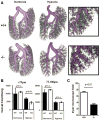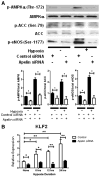Disruption of the apelin-APJ system worsens hypoxia-induced pulmonary hypertension
- PMID: 21233449
- PMCID: PMC3113525
- DOI: 10.1161/ATVBAHA.110.219980
Disruption of the apelin-APJ system worsens hypoxia-induced pulmonary hypertension
Abstract
Objective: The G-protein-coupled receptor APJ and its ligand apelin are highly expressed in the pulmonary vasculature, but their function in this vascular bed is unclear. We hypothesized that disruption of apelin signaling would lead to worsening of the vascular remodeling associated with pulmonary hypertension (PH).
Methods and results: We found that apelin-null mice developed more severe PH compared with wild-type mice when exposed to chronic hypoxia. Micro-computed tomography of the pulmonary arteries demonstrated significant pruning of the microvasculature in the apelin-null mice. Apelin-null mice had a significant reduction of serum nitrate levels. This was secondary to downregulation of endothelial nitric oxide synthase (eNOS), which was associated with reduced expression of Kruppel-like factor 2 (KLF2), a known regulator of eNOS expression. In vitro knockdown studies targeting apelin in human pulmonary artery endothelial cells demonstrated decreased eNOS and KLF2 expression, as well as impaired phosphorylation of AMP-activated kinase and eNOS. Moreover, serum apelin levels of patients with PH were significantly lower than those of controls.
Conclusions: These data demonstrate that disruption of apelin signaling can exacerbate PH mediated by decreased activation of AMP-activated kinase and eNOS, and they identify this pathway as a potentially important therapeutic target for treatment of this refractory human disease.
Figures





References
-
- Rabinovitch M. Pathobiology of pulmonary hypertension. Annu Rev Pathol. 2007;2:369–399. - PubMed
-
- Launay JM, Herve P, Peoc’h K, Tournois C, Callebert J, Nebigil CG, Etienne N, Drouet L, Humbert M, Simonneau G, Maroteaux L. Function of the serotonin 5-hydroxytryptamine 2B receptor in pulmonary hypertension. Nat Med. 2002;8:1129–1135. - PubMed
-
- Giaid A, Yanagisawa M, Langleben D, Michel RP, Levy R, Shennib H, Kimura S, Masaki T, Duguid WP, Stewart DJ. Expression of endothelin-1 in the lungs of patients with pulmonary hypertension. N Engl J Med. 1993;328:1732–1739. - PubMed
-
- Rubin LJ, Badesch DB, Barst RJ, Galie N, Black CM, Keogh A, Pulido T, Frost A, Roux S, Leconte I, Landzberg M, Simonneau G. Bosentan therapy for pulmonary arterial hypertension. N Engl J Med. 2002;346:896–903. - PubMed
-
- Christman BW, McPherson CD, Newman JH, King GA, Bernard GR, Groves BM, Loyd JE. An imbalance between the excretion of thromboxane and prostacyclin metabolites in pulmonary hypertension. N Engl J Med. 1992;327:70–75. - PubMed
Publication types
MeSH terms
Substances
Grants and funding
LinkOut - more resources
Full Text Sources
Other Literature Sources
Medical
Molecular Biology Databases

